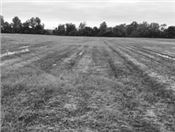New Thoughts On Burndown Strategy

Junglerice escaping glyphosate plus dicamba burndown in Titpon county TN 2019
DR. LARRY STECKEL
JACKSON, TENN.
For the last two decades dicamba has been used extensively as a pre plant burndown on almost all Tennessee cotton and soybean acres. It was often used at 8 to 12 oz/A of a Clarity-type product 14 days before planting. I know it has become tradition to use it in this fashion, but I believe this should be changed for three reasons.
First, the reason for all the dicamba use in a burndown was to target horseweed. Of course at the time, it was a weed with no effective in-season herbicide option for control. However, that is no longer the case. Most soybean and cotton acres planted in Tennessee are planted to an Xtend variety and the rest are planted to Enlist varieties. Depending upon which technology, horseweed can now be easily removed in crop with a dicamba, 2,4-D or Liberty application.
Second, it is becoming abundantly clear that the decades long use of dicamba plus glyphosate as a burndown has selected for weeds that can survive and indeed thrive in that environment. Ryegrass, poa, junglerice, barnyardgrass and goosegrass are all now regularly escaping burndown applications of dicamba plus glyphosate. I would suggest to go with glyphosate or glyphosate tankmixed with clethodim to have the best chance for success controlling those grasses before the crop emerges. Also consider using a residual that has good grass activity. Verdict would a good option here as it has both burndown activity and grass residual. Others like Anthem Max, Dual Magnum and Zidua would also be good choices.
Third, from a financial standpoint I would save the money on using dicamba before planting or even at-planting as it will likely hinder grass control. In 2019 grasses often, and Palmer in some fields, escaped the initial POST application of dicamba plus glyphosate. As such there were often 2nd or 3rd POST applications needed to control those escapes. That money used on dicamba in the early burndown could be put to better use on those follow-up applications. Recent greenhouse screens of Palmer amaranth, junglerice and barnyardgrass plants grown from seed collected from those escapes in 2019 would suggest that grass and Palmer control will be even more of an issue this spring.
Finally, it is very apparent that dicamba plus glyphosate have taken a step backwards with respect to consistent control of many grasses, and in some cases Palmer amaranth. Therefore, starting clean has never been more important. Gramoxone used right behind the press wheel will be the most important herbicide used on all our no-till soybean and cotton acres in 2020. ∆
DR. LARRY STECKEL: Extension Weed Specialist, University of Tennessee